Check out our range of stock.
Didn't find what you like?
Send us a message
Found something out of stock?
Send us a message

The Golden Panchax is an excellent surface dwelling fish for peaceful communities. The fish has a unique appearance thanks to its reflective scales, shape, and unusual mouth which appears to 'grin'. These are natural surface dwellers and will rarely swim down, so surface foods are important, as well as cover such as floating plants, tall plants, or decor at the surface. An interesting feature of this fish is a large reflective scale on the top of the head, which is used in the wild to attract insects for food. Golden panchax's are robust and adaptable and will do well in a suitable aquarium environment. Golden Panchax Facts Family Aplocheilidae (Killifishes) | Synonyms Haplochilus playfairii, Panchax playfairii, Pachypanchax playfairii, Panchax lineatus, Haplochilus lineatus, Panchax rubrostigma, Aplocheilus rubrostigma | Other names Golden wonder, Striped panchax, Sparkling panchax | Origin Asia; India, Sri Lanka | Breeding Egg scatterer | Natural Water Conditions pH 6-8, soft to hard | Natural Habitat Fresh and brackish ponds and small waterways | Sexing Males have a more intense colour, mature males may show some orange on fins Reference: https://www.thinkfish.co.uk/fish/golden-panchax.html Image from: http://animal-world.com/encyclo/fresh/Killifish/StripedPanchaxKillifish.php
$15.00

The L001 Gold Spot Pleco (Pterygoplichthys joselimaianus) is a member of the Loricariidae family of South American suckermouth catfishes. It can grow to a rather impressive size, but not so large that it will outgrow a reasonably large aquarium. Its gold spotting is very attractive and distinctive. This species is a generally peaceful fish that is extremely hardy and capable of cohabitating with most other tropical freshwater species. What We Like About This Fish: The L001 Gold Spot Pleco is a very peaceful and hardy addition to the large aquarium. This is one of the more manageable "large" plecos. This fish will not bother most plants, but it will likely help with algae control, especially as a juvenile. It will also scavenge and consume most uneaten fish food. The L001 Gold Spot Pleco is an aquarium fish with a unique appearance as well as plenty of personalities. Exceptional markings, especially as a juvenile RECOMMENDED TANK PARAMETERS: Temperature: 75° - 84° F (24° - 29° C) pH: 6.5 - 7.5 (flexible as long as sudden changes are avoided) KH: 6 - 10 dKH Minimum tank size: 75+ gallons
$60.00

The Gold Star Endler Male is an attractive fish with a stunning coloration that is sure to make a splash in any home aquarium. Its eye-catching pattern features a bright white stripe, electric blue stripes, yellow spots, and warm black markings. This fish is low-maintenance and compatible with many other aquarium species.
$10.00 - $15.00
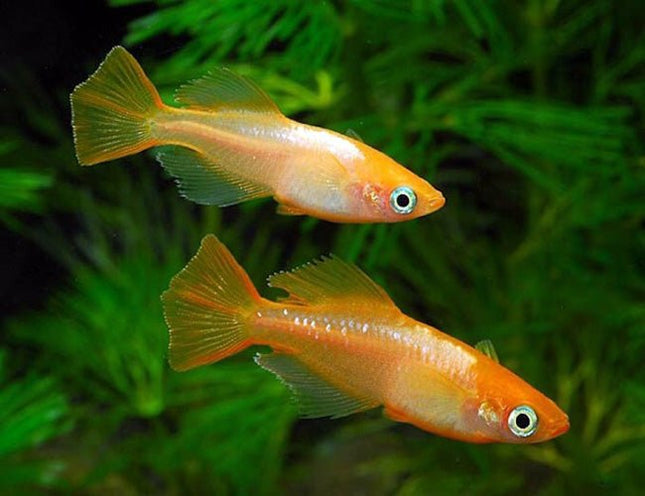
The Red Stardust Medaka is a stunning and unique addition to any aquarium. Its vibrant red color and delicate shimmering scales will captivate and inspire. This lively fish will add a touch of magic to your aquatic habitat, making it a must-have for any passionate aquarium enthusiast. IMAGE IS A PLACEHOLDER. WILL BE PUTTING IN ACTUAL PICS SOON.
$25.00
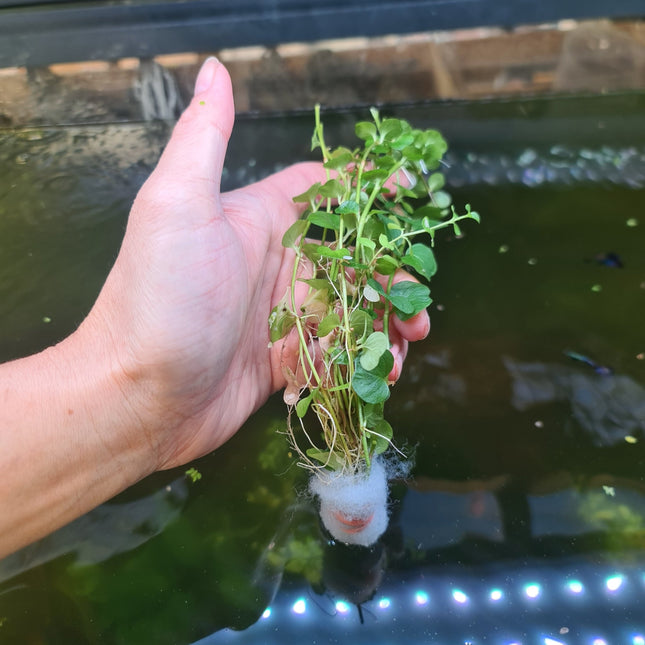
Brazilian Pennywort is a great plant for the home aquarium. It can be kept as either rooted or floating, and it will grow up toward light with its leaves shaded underneath in order to provide cover from intruders looking for safe resting spots. Brazilian Pennywort leaves offer a beautiful green colour to your tank. They're different from some other plants, like Water Sprite or Anacharis that may be more typical in an aquarium setting but are still worth keeping if you want something with interesting variety! Brazilian pennywort (Hydrocallis tr subcontracta) is quite unusual among plant life for exactly this reason: its leaf shape sets it apart visually as well as anatomically--you can tell right away just by looking at them whether they come from Brazilians or not; there's nothing else remotely similar out there anywhere nearby either inside our own country borders Aquarium pH: 6.0 – 7.8 Water Temperature: 22 – 30°C Tank Size: Any, but the plant can grow fast and take over quickly Lighting: Wide range, community tank lighting should work fine
$10.00

Characteristics Family Cyprinidae Origin Red River Basin China, Taiwan, Vietnam Social Peaceful schooling fish Tank Level Bottom, Mid-dweller Minimum Tank Size 20 gallon Diet Omnivore Breeding Egg scatterer Care Easy pH 6.0 to 8.0 Hardness Up to 10 dGH Temperature 64 to75 F (18 to 24 C) Colors and Markings The gold barb has a steeply-sloped back and short barbels positioned at the corners of the mouth. A number of dark vertical bars or blotches are visible along the flanks of the fish. Well-conditioned specimens may also have red coloration on the fins. The naturally occurring color of this barb is green, but the green P. semifasciolatus is rarely seen in the aquarium trade due to the overwhelming popularity of the gold form. Virtually all specimens currently sold are captive-bred, and a few other color variations have subsequently arisen, including an albino variant as well as a tricolor variation. This gold form was selectively bred by Thomas Schubert in the 1960s and was at one time thought to be a distinct species, referred to as Barbus schuberti or P. semifasciolatus var. schuberti. It is now known to be the same species as the wild form. Tankmates Gold barbs are schooling fish and should be kept in groups of at least a half-dozen or more. The peaceful nature of this species makes them an excellent choice for community aquariums of other similarly-sized peaceful fish including tetras, danios, and other small barbs. Gold Barb Habitat and Care Gold barbs are quite hardy and undemanding of water conditions or habitat essentials. They originate in free-flowing streams and rivers, so use a powerhead to provide a decent current. They should be provided with a good-sized open space for swimming, along with plants, driftwood, or other decors for use as hiding spots. Use a fine-grade substrate, preferably of a darker color to showcase the colors of the fish. Gold Barb Diet and Feeding In their natural habitat, this species lives on a diet of insects and their larva, as well as worms, vegetation, and even detritus. It's a prime example of an omnivore, eating just about anything available. To maintain optimal health, a varied diet is advisable. Flake, pellet, freeze-dried and frozen foods will all be readily accepted. When possible, include live foods such as insects, brine shrimp, and worms of all types. Fresh vegetables are an excellent added supplement. Gender Differences Females are overall much duller in coloration and larger than the male, as well as rounder in the belly. The belly of mature males who are ready to spawn will turn red to red-orange in color. Breeding the Gold Barb Gold barbs are relatively easy to breed, but as with breeding most fish species, a separate breeding tank is recommended. The tank should be well-planted with fine-leafed plants such as java moss. Spawning mops can also be used. A mesh cover could be placed over the bottom of the tank to allow the eggs to fall through. Regardless of which medium is used for spawning, make sure there are plenty of hiding spots for the female, as the male can be quite aggressive during the spawning process. Lighting should be dim, and the water should be soft at about 8 dGH, with a pH between 6 and 7. Use a sponge filter with a very gentle flow. Spawning can be attempted with pairs or by using the group method. When spawning in a group, use a half-dozen of each sex. If spawning in pairs, maintain separate tanks of males and females. Select the plumpest female and most brightly colored male, and introduce them to the spawning tank late in the day. Prior to spawning with either method, condition the breeders for several days with live foods. Typically, spawning occurs in the early morning around dawn. Males will begin to circle the female, nudging her in order to position her near the area he has selected for spawning. The female will release up to 300 eggs, which will then be fertilized by the male. Adults will readily eat the eggs, so as soon as the eggs have been fertilized, the adults should be removed from the tank. The pale yellow eggs will hatch in about 48 hours, and the fry (baby fish) will be free swimming in a few days. Feed the fry on infusoria, fine fry food, and freshly hatched brine shrimp. Both the eggs and fry are rather sensitive to light, so keep the tank as dark as possible until the fry are several weeks old.
$5.00
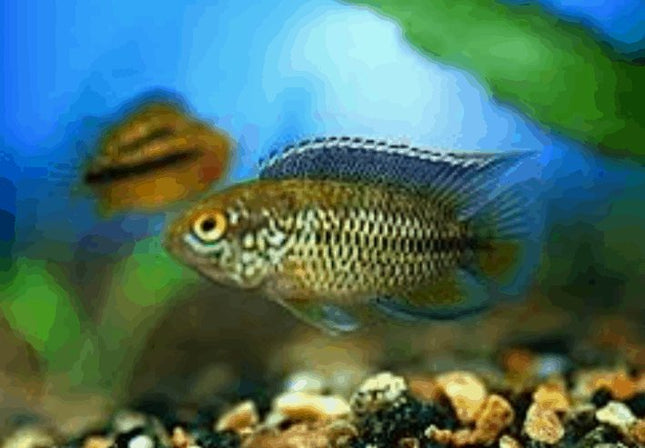
The Golden Dwarf Cichlid, or Nannacara Anomala, is a tropical freshwater fish native to South America. It is a small, peaceful fish that can be found in a variety of colors, including yellow, purple, and blue. Its body is laterally compressed, with a rounded head and a slightly pointed snout. It is an omnivore that feeds on small insects, algae, and plant matter. This species is quite popular in the aquarium trade due to its attractive coloration and peaceful nature. It is also relatively easy to care for, making it an ideal starter fish for novice aquarists.
$25.00

The guppy (Poecilia reticulata), also known as millionfish and rainbow fish, is one of the world’s most widely distributed tropical fish, and one of the most popular freshwater aquarium fish species. It is a member of the family Poeciliidae and, like almost all American members of the family, is live-bearing. Guppies, whose natural range is in northeast South America, were introduced to many habitats and are now found all over the world. They are highly adaptable and thrive in many different environmental and ecological conditions. Male guppies, which are smaller than females, have ornamental caudal and dorsal fins. Source: Wikipedia contributors. (2019, October 18). Guppy. In Wikipedia, The Free Encyclopedia. Retrieved 03:08, October 19, 2019, from https://en.wikipedia.org/w/index.php?title=Guppy&oldid=921955733Picture: https://www.azgardens.com/wp-content/uploads/2017/06/Gold-Cobra-Guppy-Pair.jpg
$20.00

Golden Pencilfish is a slow-moving, relatively peaceful species that do best with six or more of their own kind in a biotope setting. You can house them in a community tank environment with similarly sized fish, but they will not fight with more extensive or boisterous tankmates. The Golden Pencilfish sports an elongated body that is gold with a silvery band along the middle of the flanks joined above by a reddish band, and below by a blackish band with a creamy-white underbelly. It displays a black spot on the lower half of its gill covers and has a red caudal fin.
$6.95
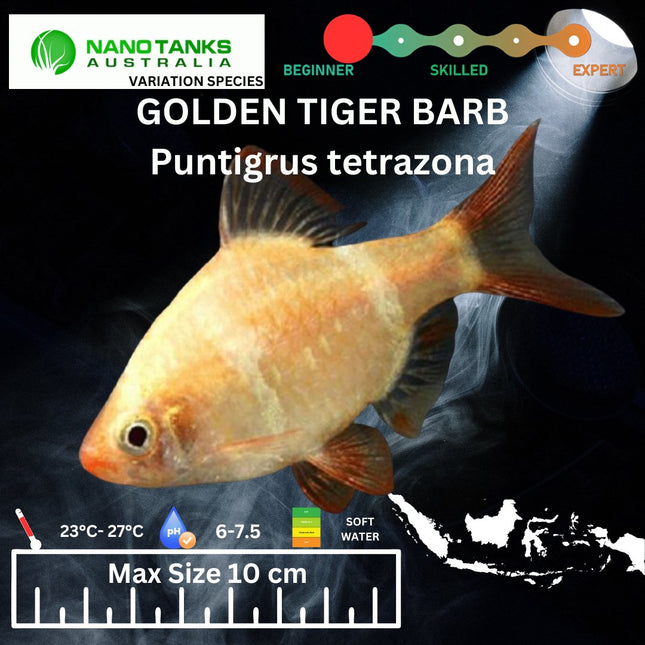
Appearance Tiger Barbs have an iconic look that even novice fish-keepers will instantly recognize. The body of the fish is quite wide. It’s tallest at the middle point and tapers down to a triangular-shaped snout. These fish are also quite colorful and have a very distinct pattern. The base color of Tiger Barbs is usually golden yellow. Some also have subtle rose gold tint. On top of that base color are several stripes. Care Tiger Barb care isn’t too difficult and can be handled by aquarists without much experience (assuming you stick to the recommendations in this guide). Otherwise, they wouldn’t be as widespread as they are! In general, these fish are relatively hardy and can adapt to simple setups as long as you cover the basics. That said, there are some aspects of their care that’ll require a bit of special attention. Despite their small size and beautiful looks, their strong personalities can be a handful! Here are the main care recommendations you need to know. Tank Size The minimum tank size for a small group of Tiger Barbs should be at least 20 gallons. However, we recommend going with a 30-gallon tank if you can. As we mentioned earlier, these fish are avid swimmers. The more room they have, the better. Plus, ample room to swim may help stave off aggressive behavior. Water Parameters In the wild, you can find Tiger Barbs inhabiting lakes, streams, and swamps that are lined with trees. Thanks to the decaying plant matter in the water, conditions tend to be more acidic. For the best results, you need to mimic their natural environment as closely as possible. That includes getting the water conditions just right. Luckily, the Tiger Barb can tolerate a generous range of conditions. As long as you stick within the following ranges, your fish should have no problem staying healthy. Water temperature: 68°F to 82°F degrees (aim for around 74°F if possible) pH levels: 6.0 to 8.0 (a slightly acidic 6.5 is best) Water hardness: 4 to 10 dKH To ensure that the aquarium has the proper water parameters you should invest in a reliable and accurate test kit. This will help you have confidence in the readings you’re getting, allowing you to make the right adjustments when necessary.
$8.00

General care for shrimp: Temperature:18°-24°C Chlorine/chloramines: 0 ppm (very toxic for shrimp) Ammonia/Nitrite: 0 ppm. Nitrate: <20 ppm. pH: 6.2-7.5. GH: 4-8 dGH KH: 3-15 dKH Name Optimal TDS Limits Cherry shrimp 150 – 200 100 – 400 Cardinal shrimp 100 50 – 150 Tiger shrimp 180 – 220 100 – 300 We strongly recommend to drip acclimate any shrimp untill the TDS matches before you release the shrimp into your tank. Please note the above is just a general indication of the care requirements of shrimp. Results will vary depending on the individuals set up.
$8.00 - $12.00

The guppy (Poecilia reticulata), also known as millionfish and rainbow fish, is one of the world’s most widely distributed tropical fish, and one of the most popular freshwater aquarium fish species. It is a member of the family Poeciliidae and, like almost all American members of the family, is live-bearing. Guppies, whose natural range is in northeast South America, were introduced to many habitats and are now found all over the world. They are highly adaptable and thrive in many different environmental and ecological conditions. Male guppies, which are smaller than females, have ornamental caudal and dorsal fins. Source: Wikipedia contributors. (2019, October 18). Guppy. In Wikipedia, The Free Encyclopedia. Retrieved 03:08, October 19, 2019, from https://en.wikipedia.org/w/index.php?title=Guppy&oldid=921955733
$8.00 - $10.00

CW009 Green Laser Cory (Corydoras sp. “green laser”) Origin: Wild Peru Locale: Rio Ucayali outside Pucallpa Diet: Insects, invertebrates, most sinking frozen & prepared feeds Adult Size: 2.5″ Recommended Tank Size: 20 gallons Compatibility: Peaceful, excellent community fish Preferred Water Parameters pH: 6.0 – 7.5 Temperature: 26 - 28C Ammonia: 0ppm Nitrite: 0ppm Nitrate: <30ppm
$120.00

Scientific name: Homalopteroides tweediei (Herre, 1940) Common name: Lizard fish, Lizard catfish, Gecko fish Synonyms: Homaloptera tweediei Distribution: Mekong basin, Malay Peninsula and Indonesia, Borneo, Cambodia, Loas and Thailand Sexual Dimorphism: Unknown, Females are probably more plump with a broader body like the very similar Homaloptera smithi. Maximum size: 2 inches (4cm) Similar to: Homaloptera johorensis, Homalopteroides smithi Care: Typical Hillstream conditions. This species needs clean, well oxygenated water with a strong flow. There should be plenty of flat stones on which the fish can rest and plenty of hiding places. Driftwood, caves, broad leaved plants, and pieces of slate leaned against the tank glass provide refuge for this somewhat shy species. Feeding: Bloodworms and brine shrimp are the preferred food of this species. Most processed fish foods are ignored. Water parameters: pH:6.4 -7.5 Hardness: medium Max dh: 12 Temperature: 70ºF to 76ºF (21-25°C) Breeding: There is no record of this species breeding in captivity.
$50.00

The Green Metal head Snakeskin Guppy, also known as the Green Cobra Guppy, is a popular freshwater aquarium fish that is highly sought after by aquarium enthusiasts. These guppies are known for their metallic green body color and snakeskin-like pattern, with a black tail that adds to their striking appearance. The males of this species have longer and more colorful fins than the females, and are typically larger in size. They can grow up to 1.5 inches in length and have a lifespan of around 2 years with proper care. Green Metal head Snakeskin Guppies are peaceful and can be kept with other peaceful fish species in a community tank. They require a well-maintained aquarium with plenty of hiding places, and appreciate the addition of live plants and a good filtration system. Their diet should consist of a variety of high-quality flakes, pellets, and small live or frozen foods. Overall, the Green Metal head Snakeskin Guppy is a beautiful and hardy fish that can add color and personality to any aquarium.
$7.50 - $15.00

Rabbit Snails are a perfect addition to small aquariums like shrimp or nano tanks. Great for natural algae control, Rabbit Snails measure 2cm and are an ideal aquatic companion.
$15.00

Green Syngonium, also known as Syngonium podophyllum or Arrowhead Vine, is a popular houseplant and aquatic plant in the family Araceae. It is native to tropical rainforests in Central and South America, but is widely cultivated as an indoor or outdoor plant in many parts of the world. In aquariums, Green Syngonium is often used as a low-maintenance foreground or midground plant. It can grow both submerged or emersed, and is usually planted in the substrate or attached to hardscape such as rocks or driftwood. The plant has arrowhead-shaped leaves that are typically green with white or silver veins. When grown emersed, the plant can produce small white flowers. Green Syngonium is an easy-to-care-for plant that tolerates a wide range of lighting and water conditions. It prefers bright, indirect light and water temperatures between 20-28°C. It can also be grown in a wide range of water hardness and pH, but does best in slightly acidic to neutral conditions. The plant does not require CO2 injection, but can benefit from regular fertilization to promote healthy growth.
$20.00

Add a splash of colour to your aquarium with the Assorted Hi Fin Platy. These colourful tropical fish are a great addition to any freshwater tank, and their vibrant fins add beautiful detail and intrigue. Their peaceful nature makes them an ideal choice for any community tank.
$8.00
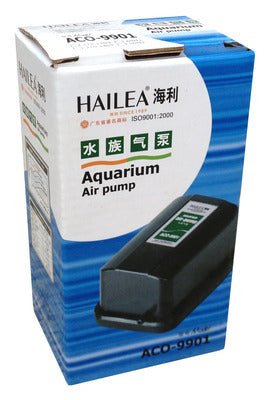
Description: Single Outlet 1.3 L/min Manufacturer: Hailea Features Small compact single outlet air pump for aquariums Modern compact design. Simple setup and operation, quick start. All models come with rubber feet, to avoid vibration. Reliable. Power usage: 2 watts Pressure: >0.01Mpa Size: 104x61x51mm Please remember to always use a check valve or non return valve.
$12.00
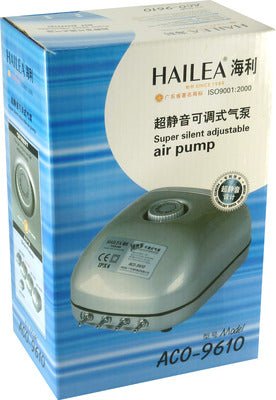
Description: 4 outlet - 600L/Hr Manufacturer:Hailea Features Hailea silent adjustable air pump Four (4) independent outlets Hailea super silent adjustable air pump These series air pumps are used for air supply parts for aquariums Possesses advanced air-compressing system and dampening system which is extremely low in noise and large in air output Adopt special artificial rubber to keep a steady air output and pressure that can be adjusted manually Environmental conservation design,non-oil lubrication to produce pure compressed air The structure is compact and can work continuously and durable for long time service Adopt non-oil design without adding lubricant Power: 10 Watt Voltage: 220/50Hz Air output: 10 L/m Pressure: 0.015 MPa Note pump uses 4 Diaphragms and 8 Flapper Valves Also used for Fitness, Cosmetic, Beauty products and Beauty Fitness devices, Healthcare devices, Health products, Processing machines, Necessities and Apparatus for the elderly and the disabled.
$60.00
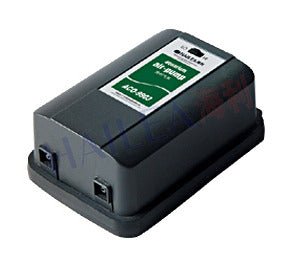
Description: Double Outlet 4.2 L/min Manufacturer: Hailea Features Small compact double outlet air pump for aquariums Modern compact design Simple setup and operation, quick start All models come with rubber feet to avoid vibration Reliable Power usage: 3 watts Pressure: >0.012Mpa Size: 138x88x52mm Please remember to always use a check valve or non return valve.
$25.00
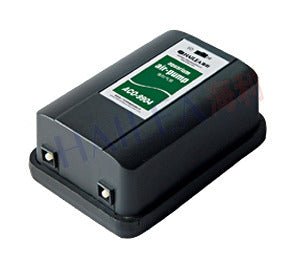
Description: Double Outlet 5.5 L/min Manufacturer: Hailea Features Small compact double outlet air pump for aquariums Modern compact design Simple setup and operation, quick start All models come with rubber feet to avoid vibration Reliable Power usage: 3.5 watts Pressure: >0.012Mpa Size: 148x98x58mm Please remember to always use a check valve or non return valve.
$28.00
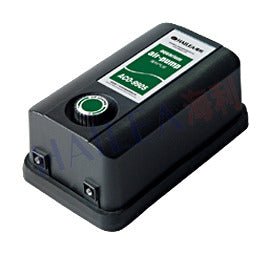
Description: Double Outlet 6.5 L/min with Variable air flow control Manufacturer: Hailea Features Small compact double outlet air pump for aquariums Modern compact design Simple setup and operation, quick start All models come with rubber feet to avoid vibration Reliable Power usage: 6 watts Pressure: >0.015Mpa Size: 158x94x68mm Please remember to always use a check valve or non return valve.
$35.00
![Hailea Aquarium FC200 6.6L [LED] - Nano Tanks Australia](http://nanotanksaustralia.com.au/cdn/shop/files/hailea-aquarium-fc200-66l-led-408415.webp?v=1744220764&width=645)
Acrylic aquarium HAILEA FC200 elegant and user-friendly will be perfect and unique decoration of your home and will create a cozy atmosphere for every room. It has a built-in filtration system, aeration system, and multi-functional air pump HAILEA BT-100B, which spreads water. The air pump is very helpful during filtration. The aquarium is equipped with a compact fluorescent bulb. This type of lighting provides high performance and low energy consumption. This illumination gives more light and works longer. This fluorescent bulb is water-proof, safe, and reliable. The aquarium is equipped with a special hole dedicated to fish feeding and dosing supplements. Characteristic: Volume: 6,6 LDimensions: 22 x 14 x 28 cmLighting: LED: 0,4 WColour: silver
$60.00

The Hailea BT100B Immerible Pump is a powerful and reliable water pump designed for a wide range of applications. This pump offers a maximum flow rate of 150 liters per hour and features a durable stainless steel motor and housing. It is designed to be fully submersible, making it ideal for use in ponds, aquariums, and other water-based applications. The Hailea BT100B Immerible Pump also features overload protection, making it safe and reliable for continuous operation.
$20.00

Hailea’s ranges of pumps are tried and tested and renowned throughout the industry for their efficiency and reliability. The HX8807 moves up to 700 litres of water per hour. Corrosion-resistant ABS plastic casing Mounted suction cups High-quality resin helps to form a sealed unit Reliable - engineered for continuous use Large sized, quality filter screen 8W Hmax 1.2m 650L/h
$25.00

Description Suitable for up to 50-110 litre fish tanks Features 400 L/hour Size (ex spray bar): 17.5cm height x 4.5cm wide x 6cm depth Reinforced ABS encasing to ensure long lasting design. High quality resin to seal motor winding - no chance of electrical leaks. High quality bio-chemical filtration sponge which is suitable for breeding nitrifier. Carbon cartridge design is better for eliminating impurities in the water. Filter includes: 1 carbon cartridge (refillable with chosen media), coarse foam block, spray bar attachment and venturi attachment for additional air Power: 7 watts Max head: 0.9m
$23.00

The Hailea Powerhead Immersible Pump PT200-PT400-PT700-PT1000-PT200 is a powerful and reliable submersible pump designed for aquariums and other water features. This pump is designed to be used in both fresh and saltwater aquariums and has a maximum flow rate of up to 2000 liters per hour. The pump has adjustable flow control and comes with an adjustable venturi for adding aeration to the aquarium water. The pump is easy to install and is fitted with a 10-foot long power cable for convenient placement. The Hailea Powerhead Immersible Pump is an efficient and reliable way to keep your aquarium clean and healthy.
$20.00

PRODUCT FEATUREScompact, low power consumption & high efficiencythw water flow regulator can adjust water flow freelyoperate stably, silently and without heatingadopts high quality resin to seal the winding for safety userotor/impeller assembly is easy to remove and convient to cleanPower - 6 wattFlow - 450 l/hrMax Jet M - 0.75Weight - 0.22kgExternal size - 54 x 47 x 52mm
$24.00

Voltage 110-115V 220-240V Frequency 50/60Hz Power 10W Output 10L/min Pressure >0.02Mpa Weight 1.3kg Package Size 179x158x164cm
$120.00

V-20 Air Hailea Pump The features of V series super silent power air pump:Adopts high quality aluminum alloy to make its case. It adopts double damping system and noise-absorbing system It is highly efficient ,energy saving,low in noise and safe.Double air chamber structure to produce large quantity of air and strong air pressure.It can work at readily and continuously. Power: 15W Output: 20L/min Voltage: 240v Weight: 2.5kg Pressure: >0.02Mpa Size: 230x185x180mm
$160.00

If you are looking to do a fish room consider this trying these Hailea Air Pumps. They are one of the most reliable air pumps that is around and that it is geared towards to budget conscious hobbyist. We personally use these air pumps within our shop and we do recommend these air pumps. The specs are: Power Consumption 25W Output 30L/min Pressure <0.025Mpa Weight 3.5kg Package Size 222*212*185
$210.00

Description: Output 3600L/Hr (60L/min). Genuine Hailea product with Australian plug and full warranty from our local suppliers. Manufacturer:Hailea Features Adopts high alumininum alloy to shape the case, double damping system and noise-absorbing function, high performance and low in noise. 1 x 8mm outlet (inside diameter). Complete with 10 outlet plastic manifold/outlet divider including small length of connecting tubing (approx 120mm length). Double flow bars to produce a large quantity of air and strong air pressure. Non-oil lubricated design to provide pure compressed air. Unique structure, quick in heat dissipation. Power consumption: 35W Pressure: > 0.03MPa 10 Outlets Weight: 5.6Kg Dimensions: 245x240x200mm
$269.00 $240.00

Check out Michel Keijman's new book - Freshwater Fishes of Cameroon. What wll be the go to reference book for the ichthyofauna found in this rich biodiversity hotspot. This book contains valuable information of freshwater fish originating from Cameroon. Aquarists can find information on its distribution range, biotope, water values, and with which other species these fish coexist. Valuable information that any serious aquarist can use to create a biotope-accurate aquarium for his fish from Cameroon. The book is divided into chapters, each covering a special family of fish. This of course includes the many cichlids, killifish, tetras, catfish, gobies and etc. There are two chapters on aquatic plants and biotopes. In short, something for everyone. And everything is very nicely illustrated with beautiful photos, many of which have never been seen before. Also shown are some newly discovered fish species (cichlids, killies and tetras) that have also never been seen before. Book Specification: Hardcover Landscape Layout Weight: 2.1 Kg Full colour 464 pages 403 species 821 photos 32 Detailed Distribution Maps Written in English. A note from David Michel has graciously offered to send 8 of his amazing books to us as a group buy. He will send this from late November and we won't expect it till around May 2024. The cost will be €79,50 for the book + Shipping to Australia + Bank Foreign Exchange Fees + GST +.Other Fees + Waiting Time If you buy direct it will cost you around $250 AUD - $270 AUD (Please note this would include GST and also Bank Foreign Exchange Fees) $25 AUD for the shipping to you (within Australia) Why buy from us? This is a group buy which means you will be getting a better rate overall. You will save on the need to send a Foreign Currency and therefore save on FX Fees and Conversions If you are in Sydney you are welcome to pickup from our store and we will refund you the $25 AUD Shipping Cost. Nano Tanks Australia is not seeking to profit from the sale of these books we want to give back to Michel for the work that he has done. We just need to make sure that we cover our cost. [IF YOU LIKE TO HELP PLEASE PAYID TO 0433784171 $250 WHICH WILL BYPASS ALL THE FEES]
$280.00

Bio Bricks 500g - Powerful Biological Filtration Boost "Your aquarium's invisible cleanup crew, supercharged!" What makes our Bio Bricks special?✔ Porous ceramic design - Massive surface area (500+ sq ft per 500g) for bacterial colonization✔ Instant cycle jumpstart - Cuts new tank cycling time by up to 50%✔ Continuous biofiltration - Supports 100L of water volume per brick How it works: Place in filter or tank Beneficial bacteria naturally colonize within 24-48 hours Maintains stable populations for years Proven benefits: Dramatically reduces ammonia/nitrite spikes Handles heavy bioloads from:• Crowded tanks• Large fish• Messy eaters Works in both freshwater and saltwater 500g bag treats:• 200L aquarium as main filtration• 400L as supplemental media The smarter way to biological filtration!
$18.00

Scientific Name Trigonostigma HengeliFamily CyprinidaepH 5.5 – 7.5DH 1 – 14Temp 22 – 28 degreesLife Span 3 – 5 years OriginSumatra & Borneo Islands in Indonesia. They reside in blackwaters and slower flowing streams. DescriptionThe Hengeli Rasbora is also called the Growlight Rasbora. Being the smallest of the trigonostigma genus the Hengeli will grow up to 3 – 4cm in length. Most of their body is translucent with the most significant feature, a bright orange marking on the lateral line from the centre of its body to the Caudal fin with a black marking underneath this. Males are not as round as females. Although this species of Rasbora is quite hardy it is not recommended to use this fish while cycling a new aquarium. EnvironmentProvide a tank that is dimly lit with lots of plants for hiding spaces as the Hengeli is a shy fish. Keep filter flow to a minimum, allowing wide open spaces for them to swim around in as they are quite energetic. A darker substrate will help to bring out the Rasbora’s colours. They can tolerate a wide range of conditions. Maintain pH from 5.5 – 7.5 and soft to moderately hard water 1 – 12 dGH. Minimum tank size for a group should be at least 100 litres. BehaviourThe Hengeli Rasbora is extremely peaceful and suitable for any aquarium with non-aggressive fish. The more placid the better. It’s a shoaling fish and best kept in a group of at least 6 or more as this makes them feel more relaxed about their environment. The more the better when it comes to shoaling fish. A hierarchy will be formed within the group. The main area of the tank it likes to reside in is the middle, but it will frequent the top and bottom as well. This species of Rasbora is a faster swimmer than other Rasbora. FoodThe Hengeli Rasbora is an omnivore so it will enjoy a wide range of foods as it is not too fussy. Flake food, worms, live and frozen food like brine shrimp, daphnia, mosquito larvae & vegetables. Keep serving sizes small as they are not big fish. DiseaseThere are no specific diseases that directly affect this species but they are prone to a variety of others. BreedingAlthough very difficult to breed in an aquarium it can be achieved. Keep water conditions optimal, providing them with soft acidic conditions. They will attach their eggs to the undersides of leaves. To induce spawning keep the tank quite dark, feed lots of live foods and even do water changes to simulate a change of seasons. So the parents do not eat their young, they should be removed after spawning. Feed young infusorians to begin, moving onto brine shrimp and then powdered fry foods as they get bigger.
$5.00 - $6.00
You have seen 648 out of 1935 products